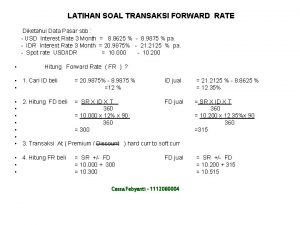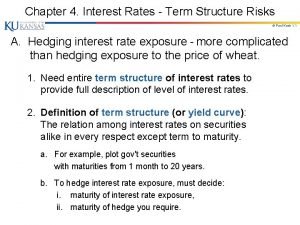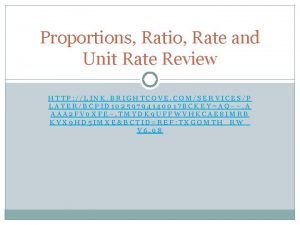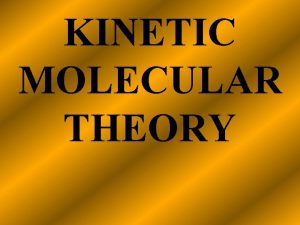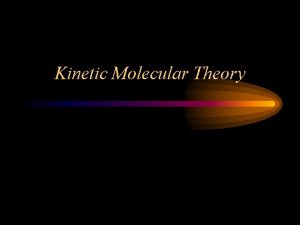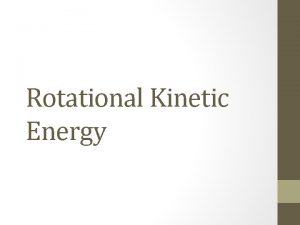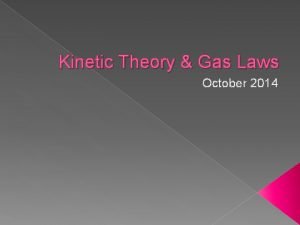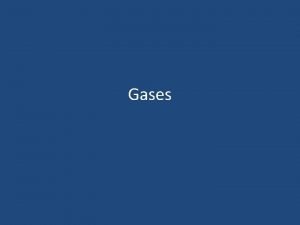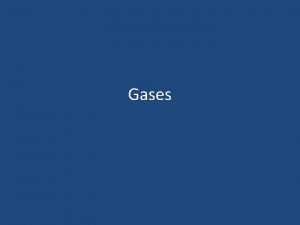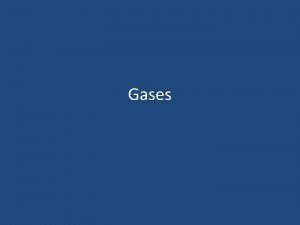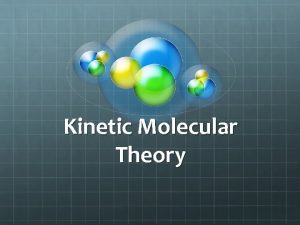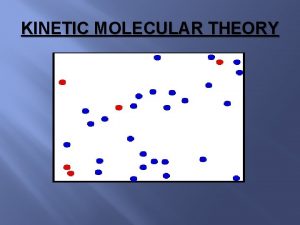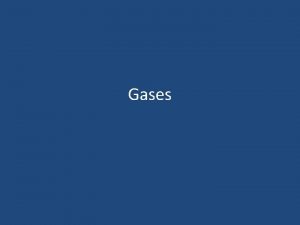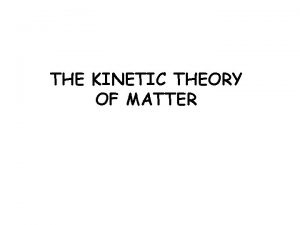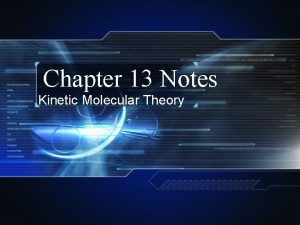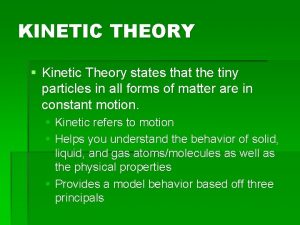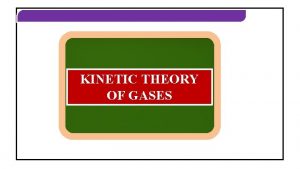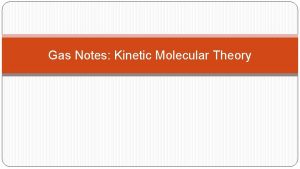KINETIC THEORY Kinetic theory studies the rate of

























- Slides: 25

KINETIC THEORY • Kinetic theory studies the rate of any observable process, such as chemical reaction, phase transformation. • In a transformation all the particles in the system do not undergo transformation instantaneously (at the same time). All transformations take some time, whether it is very short as in martensitic transformation or very long as in graphitization of cementite at room temperature. • The reactants and the products coexist together during the transformation. (Although existence of transition (activated) states is expected, presence of such states cannot be shown experimentally. )

Fraction transformed, Y(t), during a transformation may be defined as: # of atoms(molecules) transformed at time t Y(t) = ---------------------------------# of atoms(molecules) present initially at time t=0 (d. Y/dt)t 2 (d. Y/dt)t 1 Y t 1 t 2 time Slope of the curve of fraction transformed versus time gives the transformation rate, d. Y/dt.

The foundation of kinetic (rate) theory dates back to Arrhenius (1889), who found experimentally that for many processes the rate constant may be written as k = A exp (‑Q/RT) i. e. , log k is a linear function of 1/T. Q determined from the slope of log k vs 1/T plot is regarded as the heat or energy of activation. R = 1. 987 Cal / K · mole = 8. 314 J / K · mol = 0. 082 L · atm / K · mol k = 1. 38 x 10− 23 Joule / K · atom = 8. 63 x 10− 5 e. V / K · atom Ln k Q/R 1/T (K-1)

• Rate equations similar to that of Arrhenius has been derived for ideal gases by use of kinetic theory of gases during the second half of the 19 th century. This treatment is usually known as classic or collision theory. • Kinetic theory of matter is also the bases of Brownian motion, (Albert Einstein, 1905) which is irregular zigzag movement of extremely minute particles suspended in a liquid or a gas. It predicts that molecules of matter are in motion and heat is a manifestation of this motion. • In the collision theory it is assumed that the particles (molecules) are chargeless, the average kinetic energy of all the particles are directly proportional to absolute temperature and there exists a distribution of kinetic energy among the particles. • This energy distribution (proposed by Boltzmann in 1886), known as Maxwell‑Boltzmann (or Gibbs or classical) energy distribution, gives a simple picture of dynamical equilibrium between various parts of the system and may be derived from the principles of statistical thermodynamics.

Kinetic Energy = ½ m v 2

Such an energy distribution at two different temperatures is given below. As the temperature increases there is, (1) an increase in the average energy and (2) an increase in the number of particles with energies in excess of any specified value, E*. # of particles Maxwell‑Boltzmann distribution originally predicted for gas molecules, in principle for the first order approximations, may be applied to the distribution of vibrational energy of atoms in a solid. T 2 >T 1 T 2 Ē 1 Ē 2 E* Energy

• The curve giving the energy distribution may also be interpreted as time spend by a single particle at each energy level over a period of time rather than number of particles with specific energies at any particular instant of time. • As will be obvious in the following sections one is usually interested in knowing the probability of atoms possesing more than a specified amount of energy, e. g. , what fraction of the atoms has energy greater than E*. • This has been worked out from the ratio of the areas under the curve for E* to infinity and the total area by integration. n. E>E* (E*- Ē) E* ------- = exp { - -----} exp {- ----- } if E*>> Ē Ntotal k. T

• If one considers that only atoms with sufficiently high energy, i. e. , with energies greater than a critical value, E*, can take part in the chemical reaction the rate of the reaction has to be proportional to the fraction of such atoms. Hence theory leads to the Arrhenius Equation n rate ------- exp(‑E*/k. T) Ntotal

A more recent and intellectually more appealing kinetic theory is the Absolute Reaction Rate Theory (also known as Activated Complex or Transition‑State Theory), which is based on thermodynamics. A system at constant temperature and pressure is in equilibrium when Gibbs‑free energy is minimum. Therefore an equilibrium configuration of a systam is defined by d. G=0 where d. G represents the change in G when there is an infinitesimal change in the state of the system and d. G = d. E + Pd. V ‑ Td. S = d. H ‑ Td. S At constant temperature and volume Helmholtz free energy, F, may be used as equilibrium criteria, i. e. , d. F=0, where d. F = d. E ‑ Td. S Also, d. H = d. E + Pd. V Since d. V is almost zero in solid state reactions, d. G d. F and d. H d. E

Reactants Activated state Ga=Activation Energy Gd=Driving Force stable The modern rate theory G assumes that any observable process may be described adequatly in terms of the energy of the atomic confiqurations involved. One may imagine a plot of energy vs. distance (state) (reaction) coordinate as shown. metastable An equilibrium may be stable or metastable. A system is at "stable" equilibrium when its free energy is at its lowest possible value. On the other hand, states of the system for which G is a minimum in the mathematical sense satisfying d. G=0 but numerically greater than the value of G for stable equilibrium are "metastable". It is possible to bring a system to a state where any infinitesimal change in the state reduces G. Hence the change is favorable and will continue until the system reaches an equilibrium state. Such a state is called "unstable state". Products Reaction Coordinate

Activated state Ga=Activation Energy Reactants Gd=Driving Force stable G metastable This path is considered to be the predominant actual path taken during the course of reaction and is known in general as the reaction coordinate. This sort of generalization may readily be understood in terms of a mechanical analogue. The system may be regarded as a ball or marble, free to roll under the influence of gravity on a track whose height (gravitational energy) is given by the curve. Products Reaction Coordinate Any point where the marble may rest is obviously a minimum of the curve; such a point corresponds to a state of the atoms, which persists long enough to be observed as represented by reactants or products. The marble, if initially at rest at the minimum designated Reactants, would, of coarse, never of its own accord move to the minimum designated Products, even though this direction is "down‑hill" and energy is lower there, since it must first acquire the activation energy necessary to surmount the peak designated Activated complex. A chemical system at the absolute zero of temperature would be subject to the same restriction; hence, since no energy can be acquired, it is readily inferred that chemical reactions do not occur at this temperature. At any finite temperature, however, any small assemblage of atoms has a finite probability of acquiring the necessary activation energy from the energy of thermal agitation of the entire system; it is obvious that the higher the activation energy, the lower is this probability.

One other equally important but generally overlooked equilubrium state is at the maxima of the free energy curve. At that point d. G=0 and it corresponds to an equilubrium state, and this state quite different than the other two equilubrium states is known as the activated state, and the configurations at this state are known as the activated complex. The two fundamental principles of the modern reaction, rate theory are both concerned with this activated complex. They are as follows: 1. The activated complex, though of exceedingly short life, may be treated as any other chemical species (e. g. , as having a definite set of thermodynamic functions) and is in equilibrium with the reactants. The chemical equation for its formation from the reactants may be set up, and the corresponding thermodynamic equilibrium constant may be written as K+. The superscript, +, is commonly used to designate a quantity pertaining to an activited complex. If K+ and the concentrations of the reactants are known, the concentration (strictly, activity) of the activated complex is readily calculable therefrom in the same way as for any other equilibrium, i. e. , using the free energy of formation of the activated complex, F+=‑RT ln K+.


If the reactants be designed R 1, R 2, etc. , and the activated complex A, the chemical reaction formation of the activated complex becomes R 1 + R 2 +. . . . = A and the equilibrium constant is where a represents activity, C concentration (usually in moles per unit volume), and the activity coefficient. The reaction rate, or number of moles of activated complex per unit volume that decompose per unit time, is (RT/Nh)C+. Substituting for C+ from the expression for K+, it is then found that The coefficient k of the concentration terms is known as the specific reaction rate constant.

The expression relating F+ and K+ may be rewritten in exponential form as K+ = exp(‑ F+/RT) = exp(‑ H+/RT) exp( S+/RT) the second equality following from F = H ‑ T S. Inserting this expression for K+, the reaction rate may now be written as: and the specific reaction‑rate constant (the coefficient of the concentration terms) is If the activity coefficients are unity, this simplifies to

If, further, H+ and S+ are essentially independent of temperature, it will be noted that the expression is of the form k = a T exp(‑ H+/RT) where the constant a = (R/Nh) exp( S+/R). This expression gives the expected temperature dependence of the specific reaction‑rate constant. Relatively little error, over a small temperature range, is involved in the approximation k = a e Tm exp[‑( H+ + RTm) / RT] where Tm is the mean temperature of the range under consideration. This form is identical with the old formulation of Arrhenius, who wrote k = Ae‑Q/RT

Returning now to the more general formulation but considering H+ and S+ constant, the expression for the reaction rate is conveniently written in six terms: 4 1 2 3 5 6 The following facts are to be noted about these terms (the first four together constitute the specific reaction‑rate constant): 1. The first term contains only universal constants and the absolute temperature and hence is independent of the particular reaction under consideration. 2. The second term is the principal temperature‑dependent term, involving the enthalpy (heat) of activation. 3. The third term depends on the entropy of formation of the activated complex. In a general way, it is to be expected that, if the activated complex is relatively simple, S+ is small and, if it is complicated (as compared with the reactants) in atomic configuration, S+ is large and negative. 4. The fourth term involves the activity coefficients, which may or may not remain essentially constant (or unity) during the course of reaction. 5. The fifth term, which is the only one of the five not included in the specific reaction‑rate constant, is the product of the concentrations of the reactants. 6. The transmission coefficient, p , is the probability that the activated complex will decompose to products rather than to the reactants from which it was formed.

Energy A superimposed plot of Energy vs reaction coordinate and Boltzmann Energy distribution is very instructive in understanding the rate theory. Shaded areas give the number of atoms capable of surmounting over the activation barrier. G 3 Ga G 2 Gd G 1 # of particles Reaction Coordinate

G 3 Ga G 2 G 1 Gd= G 2 ‑ G 1 = driving force Ga(2 1) = G 3 ‑ G 2 = G 32 = activation energy for the forward reaction. Ga(1 2) = G 3 ‑ G 1 = G 31 = activation energy for the backward reaction. The rate of the forward reaction (2 1) n 2 exp (‑ G 32/k. T) The rate of the backward reaction (1 2) n 1 exp (‑ G 31/k. T) The net reaction rate = n 2 exp (‑ G 32/k. T) ‑ n 1 exp (‑ G 31/k. T) = exp (‑ G 32/k. T) [n 2‑n 1 exp (‑ G 21/k. T)] = exp (‑ Ga/k. T) [n 2‑n 1 exp (‑ Gd/k. T)]

The net reaction rate = n 2 exp (‑ G 32/k. T) ‑ n 1 exp (‑ G 31/k. T) = exp (‑ G 32/k. T) [n 2‑n 1 exp (‑ G 21/k. T)] = exp (‑ Ga/k. T) [n 2‑n 1 exp (‑ Gd/k. T)] • If G < 0 then G 32 < G 31 net reaction is in the forward direction. • If the driving force is very large, G<<0 then G 32<< G 31 exp (‑ G 32/k. T) >> exp (‑ G 31/k. T) net reaction rate n 2 exp (‑ G 32/k. T) • If the net reaction rate is zero, system reaches to dynamical equilibrium. Forward and backward reactions continue but equal number of particles are transferred in opposite directions n 2 exp(‑ G 32/k. T) = n 1 exp(‑ G 31/k. T) n 2/n 1 = exp{‑ Gd/k. T} = equilibrium constant

In the kinetic theory the system is assumed to be isothermal rather than adiabatic. Therefore as the particles with free energies greater than the activation energy transform to the stable state, but the average energy and the energy distrisbution do not change. The energy of the remaining lower energy atoms in the metastable state is raised by thermal vibrations. Such a process where the average energy stays constant due to the isothermal nature of the process is known as thermally activated process. To understand thermodynamic equivalent of the activation energy of the Arrhenius equation (which is usually determined from the slope of the ln rate vs l/T plot) one has to rewrite theoretical rate equation as: rate exp[‑( Ha‑T Sa)/k. T] exp ( Sa/k) exp(‑ Ha/k. T) where, Ha is the activation enthalpy (equivalent to activation energy, Q, of Arrhenius equation) and composed of potential energy due to atomic bonds and kinetic energy of thermally induced motion of the particles, Sa is the activation entropy, and equal to the difference in entropies of the atoms in the initial and activated states. According to statistical thermodynamics, Sa = k ln(wa/wi)where wa and wi are the number of complexions (possible distributions) associated with the activated and initial states.

The activation energy, Q, of the Arrhenius equation is actually equal to the activation enthalpy or activation internal energy. Q is usually assumed to be temperature independent. According to Kirchoff's law temperature dependence may be given as Ha(T 1) = H(T 2) + (Cv(a) ‑ Cv(i)) d. T where Cv(a) and Cv(i) are the specific heats at constant volume in the activated and initial states, respectively, and Ha(T 1) and Ha(T 2) are the activation energies at two different temperatures. If Cv(a) Cv(i) then Ha f(T) as usually determined experimentally, Q f(T)

It is to be emphasized that the foregoing discussion of reaction rate may be applied at any one time to only one particular step in a chemical reaction or a single atomic process. But in real world, the usual over‑all chemical reaction or phase transformation consists in general of several chains of reactions or atomic steps all proceeding simultaneously. The complications introduced thereby may be so great as to make the calculation prohibitively difficult, and the experimental rate measurements may deviate considerably from the above given theoretical results. If a general process is composed of two or more atomic processes then the overall reaction rate depends on whether these atomic processes are dependent to each other or independent from each other. With analogy to fluid flow or electrical circuits, if the atomic processes are dependent then they are known as series processes and if they are independent then they are known as parallel processes. Fluid flow and electrical analogies of these two types of processes and the corresponding analogous equations are as follows are

Dependent (Series) Independent (Parallel) 1 1 2 = 1+ 2 1/I=1/I 1+1/I 2 2 1/ = 1/ 1+ 1/ 2 rate= rate 1 + rate 2 Ln rate 1/rate = 1/rate 1 + 1/rate 2 I=I 1+I 2 1/T

In general, if |rate 1 ‑ rate 2| >> 0 then an asymtotic behaviour is observed such that: • If the processes are in series then the slower one dominates and controls the overall process. • If the processes are in parallel then the faster one dominates and controls the overall process. High temperature deformation may be given as a metallurgical example. Possible high temperature deformation mechanisms are 1‑ Diffusion creep 2‑ Grain boundary sliding 3‑ Dislocation creep ((3 a)Climb + (3 b)Glide) These three process are independent but dislocation creep itself is composed of two dependent processes. Therefore the overall rate of creep by analogy may be determined by equations given above. 1 2 3 a 3 b
 Paradigm shift from women studies to gender studies
Paradigm shift from women studies to gender studies Plate and rate theory of chromatography
Plate and rate theory of chromatography Cap rate interest rate relationship
Cap rate interest rate relationship Real vs nominal interest rate
Real vs nominal interest rate Define growth analysis
Define growth analysis Transaksi forward
Transaksi forward Addison currency exchange
Addison currency exchange Spot rate and forward rate
Spot rate and forward rate Spot rate and forward rate
Spot rate and forward rate Difference between rate and unit rate
Difference between rate and unit rate Hát kết hợp bộ gõ cơ thể
Hát kết hợp bộ gõ cơ thể Ng-html
Ng-html Bổ thể
Bổ thể Tỉ lệ cơ thể trẻ em
Tỉ lệ cơ thể trẻ em Gấu đi như thế nào
Gấu đi như thế nào Chụp tư thế worms-breton
Chụp tư thế worms-breton Hát lên người ơi alleluia
Hát lên người ơi alleluia Môn thể thao bắt đầu bằng từ chạy
Môn thể thao bắt đầu bằng từ chạy Thế nào là hệ số cao nhất
Thế nào là hệ số cao nhất Các châu lục và đại dương trên thế giới
Các châu lục và đại dương trên thế giới Cong thức tính động năng
Cong thức tính động năng Trời xanh đây là của chúng ta thể thơ
Trời xanh đây là của chúng ta thể thơ Cách giải mật thư tọa độ
Cách giải mật thư tọa độ Làm thế nào để 102-1=99
Làm thế nào để 102-1=99 độ dài liên kết
độ dài liên kết Các châu lục và đại dương trên thế giới
Các châu lục và đại dương trên thế giới





